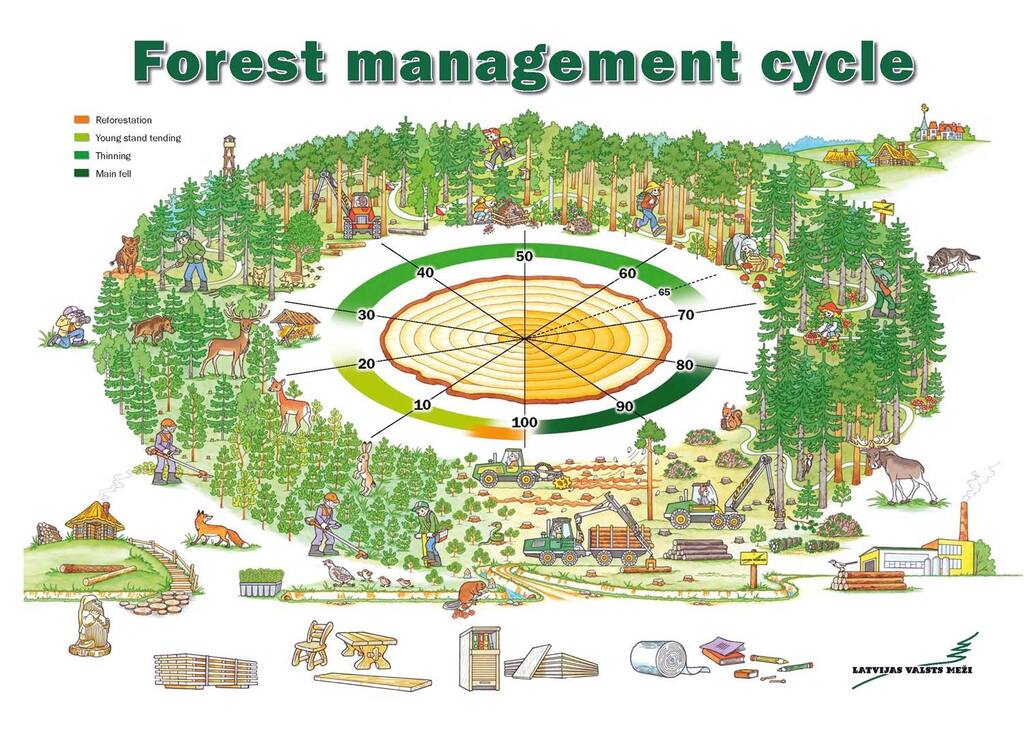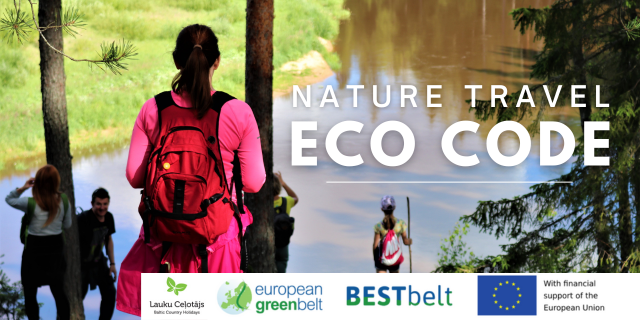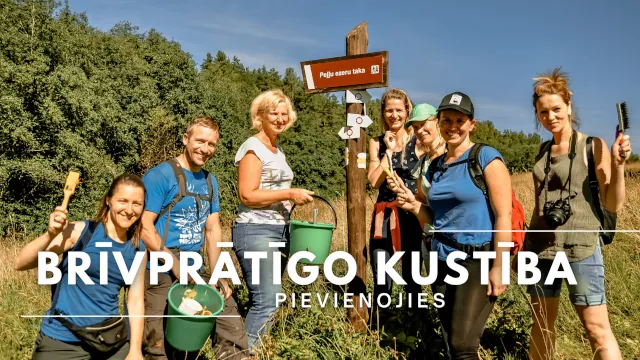Baltic Forest Hiking Route - Nature
The Southern part of the Forest Trail (Polish/Lithuanian border - Riga)
- The Southern part of the Forest Trail passes through three national parks — those of Dzūkija and Žemaitija in Lithuania and Ķemeri National Park in Latvia. Ķemeri Bog with the surrounding swamps and wet forests is among the largest wetlands in the Baltic countries. In total, the Forest Trail passes through or by about 25 specially protected nature areas.
- The Southern part Forest Trail passes through Sūduva, Dzūkija and Žemaitija Uplands in Lithuania, and Rietumkursa and Austrumkursa Uplands or parts thereof in Latvia. The uplands are interspersed with lowlands, e.g. Kursa Lowland and Piejūras Lowland The lowest stretches of the Forest Trail lie at sea level (Bigauņciems–Lielupe section, where the Forest Trail passes along the coast of the Gulf of Rīga), while the highest point — Šatrijos kalnas (228 m above sea level) — is located in Žemaitija Upland.
- Upland areas are rich in lakes. The Baltic States are covered by a dense network of bigger and smaller rivers and streams that provide a pleasant refreshment in summer.
- Along the Southern part of the Forest Trail, highly distinct terrain is found along of the Nemunas and the Dubysa, in the Abava Valley, and along the tributaries of those rivers.
- There are many natural heritage objects, such as enormous boulders, springs, giant trees, avenues and interesting forms of terrain, such as hills, ravines, river valleys etc, in the vicinity of the Forest Trail. Banks of the Nemunas and its tributaries feature majestic and spectacular sediment material outcrops.
- Along the Latvian coastline, dune habitats, protected on the European Union level can be seen.
Northern part of the Forest Trail (Riga - Tallinn)
- A part of the Northern Forest Trail runs through Vidzeme, Alūksne and Haanja Uplands, while some parts pass through lowlands. The lowest parts of the Forest Trail are at sea level, and the highest point (~256 m above sea level) is located at the foot of Suur Munamägi Hill. The second highest point is the Drusku castle mound (246 m above sea level). Suur Munamägi Hill (318 m above sea level) is the highest summit in the Baltic States.
- Distinct terrain is found in the ancient valley of Gauja River and the ravines of its tributaries, as well as in the territory of the North-Estonian Klint – a steep and rocky 56 m high cliff stretching along the northern coast of Estonia. For five days, the Forest Trail runs through the ancient valley of the Gauja River, the largest and deepest valley in the Baltic States, and later winds along the North-Estonian Klint for five more days in the Toila–Kunda section of the trail.
- The Trail passes by the following natural heritage sites: Ehalkivi, the largest giant boulder in the Baltic States (930 m3), Valaste waterfall, the highest waterfall in the Baltic States (26 m), Jägala waterfall, which is one of the most impressive waterfalls in the area. Magnificent sandstone outcrops with natural and man-made caves rise on the banks of the Gauja and the Piusa rivers. The Piusa caves is the longest system of man-made underground sandstone caves in the Baltic States. Million-year-old fossils can be seen on the shores of the Gulf of Finland.
- The Northern part of the Forest Trail passes through three national parks, of which Gauja National Park is the oldest national park in Latvia, and Lahemaa National Park is the oldest in Estonia and the Baltic States. Alutaguse National Park (established in 2018) is the newest of the 15 national parks in the Baltic States. In total, the northern part of the Forest Trail passes through or by approximately 40 specially protected nature territories.
- For more than a week, the Forest Trail runs along Lake Peipus, the fourth largest lake in Europe (along with Lake Pskov). The locals have been growing onions here since the Tsar’s times, selling beautiful onion strings on roadside. Beautiful dunes up to 13 m high have formed along the northern shores of Lake Peipus.
- There are several islands off the trail in Northern Estonia that are great for shorter hikes to see more of the nature and local culture – Pedassaar, Prangli, Aegna, Naissaar.
Generally about the Forest Trail
- The Forest Trail passes through some of the most wooded areas of Lithuania, Latvia and Estonia, and hikers get to see most of the forest habitats and forest types present in the Baltic States. It passes by massive trees of different species and trees related to historical events and stories.
- The Forest Trail is a great place for bird and animal watching. Here you can observe Europe’s second largest animal, the moose. If you are silent enough, there’s a chance you’ll see roe deer, red deer, foxes, hares, martens, otters, squirrels and hedgehogs. There might be footprints of wolves and lynxes. Beavers, who cut trees and make their homes near by the water, are quite common as well.
- Bird watchers can observe (or hear) the black and white stork, lesser spotted eagle, corncrake, Eurasian pygmy owl, greenish warblers, various species of owls and woodpeckers, including the largest woodpecker in Europe, the black woodpecker, and the common kingfisher.
- Natural disasters are uncharacteristic to the Baltic States. Strong storms are rare, and usually occur in autumn or winter. There are no tides on the seashore that would restrict movement along the seashore or render it unsafe. Water levels are higher during strong winds and storms.
- During the summer, sea water temperatures can reach +18°C – +20°C or higher – +26°C. Inland waters may also have higher water temperatures. Prolonged periods of rainfall and lower air temperatures are possible during the summer, spring and autumn, so be sure to check on the weather before you go.
- Residents of Lithuania, Latvia and Estonia love wandering out in the forest to forage wild food, mostly mushrooms and wild berries such as bilberries, lingonberries and raspberries, as well as cloudberries and cranberries in marshy forests and bogs. Wild herbs can be used to brew medicinal teas.
Forest diversity
Every human associates the forest with something else. For some, a true forest comprises of tall, slender pine trees and white moss, while for others, the first association is a primary forest with moss-covered fallen trees. Some people will think of a birch grove with humid valley floors covered with kingcups. Forests are diverse, but each and every one of them has a role to play in maintaining biodiversity. The following are just a few of the forest types present in Lithuania, Latvia and Estonia. Each has its own place, meaning and use.
Boreal forest or northern coniferous forest is a biome characterised by spruce and pine stands of different ages. These are natural and old forests with a great diversity of species. Forests with a diverse population age structure and size of trees which form glades are important for nature. Boreal forests may have been subject to human influence, but no clearcutting has been carried out in these forests for at least several hundreds of years. In Latvia, the Forest Trail passes through excellent habitats of the Boreal forests, while towards the south, the Boreal forests are gradually replaced by broad-leaved (so-called nemoral) forests, increasingly featuring oaks, lime-trees and species of trees, such as the common hornbeam, that in the wild are encountered in the southwestern part of Kurzeme, where the climate is milder. Large areas of the Boreal forests can be found also in southern Lithuania, for example, in Dzūkija ethnographic region.
There is no single dominant tree species in broadleaf forests. They retain elements characteristic of forests with low forestry impact and important for maintaining biodiversity – hollow trees, snags, deciduous trees, which are essential for the survival of many plant, insect, bird and animal species.
Marsh tea, cranberries and various sphagnum species, as well as small pine trees, spruce trees, bog birch, black alder, small shrubs and sword grasses grow in marshy forests.
Wet floodplain broadleaf forests or alluvial forests which grow on coasts and banks are often seen besides watercourses. This forest type is quite common near the Gauja, the Nemunas or the Dubysa River.
Forests growing on slopes and ravines near river valleys are incredibly picturesque. Here, coniferous trees grow together with oaks, lindens and elms. Often, the landscape is adorned by glorious outcrops and caves, small watercourses that increase the biodiversity of the area.
Oak forests, composed of oak, lime-tree and common hornbeam stands, are widespread in Lithuania. Oak forests grow in the valley of the Nemunas and near other large rivers.
In the broader sense, forests are made up of many stands formed at various periods of time, which have grown unevenly and have formed under different historical and economic conditions, both naturally and with human involvement. The diverse forests provide room for many residents, who all have different demands regarding living conditions. The balance between nature conservation and forest management ensures that we can enjoy the forest and take walks, gather mushrooms and berries, as well as reap the economic benefits.
Forest management
The Forest Trail passes through both protected and commercial forests. Forest management in commercial forests is based on an 80 to 120-year forest management cycle.

Image: Latvia’s State Forests
The forest management cycle covers the life cycle of a forest stand. It starts with seeds from specially selected trees, which are grown to seedlings in nurseries. Young trees are planted under the best growing conditions for each specific species of tree. It regenerates the forest and creates a young forest stand.
A forest demands care in order for it to grow beautiful and valuable. When the trees reach a height of 1.5–2 meters, foresters thin out the stand to lessen competition for the healthier and more valuable trees, and form the composition of the forest. It is the basis for a valuable and healthy forest which is resistant to snowfall, strong wind and other kinds of damage. Tree stands are thinned two to three times per year over a period of several years. Bilberries, forest strawberries and raspberries grow thick in young forest stands.
For the forest to continue to grow beautiful, it must also be cared for when it ages to mid-succession. This allows the trees to develop hardy trunks and a thick crown of leaves which binds more carbon dioxide.
When trees reach a height of 12 m, the forest is thinned to give the trees more space, providing them with light and room for growth. Mid-succession stands are thinned 1 to 2 times, as necessary.
As the forest reaches the age of main harvesting, a continuous felling is carried out to give room for a new forest. With this step, the forest management cycle closes, and begins anew with the planting of new seedlings.
Nowadays, special importance is paid to environmentally, economically and socially responsible forest management, which enhances the value of the forest, cultivates productive stands, produces various wood and non-timber forest products, as well as provides opportunities to spend time in the forest.










